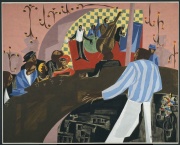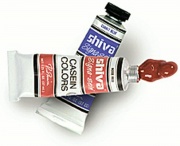Difference between revisions of "Casein paint"
(username removed) |
|||
| (4 intermediate revisions by 3 users not shown) | |||
| Line 1: | Line 1: | ||
| − | [[File:1990.378-C46723CR-d1.jpg|thumb|]] | + | [[File:1990.378-C46723CR-d1.jpg|thumb|Café Comedian<br>MFA# 1990.378]] |
== Description == | == Description == | ||
| − | A water-based, matte paint with a [ | + | A water-based, matte paint with a [[casein]] binder. Dry casein is hydrolyzed with alkalis ([[lime casein|lime]], [[borax casein|borax]], [[ammonium casein|ammonia]], etc.) to form a clear viscous solution. Casein paints dry to a matte, brittle film that is insoluble in water and impervious to most paint strippers. It may sometimes be removed with strong [[alkaline]] or [[ammonium hydroxide|ammonia]] solutions. Casein paints have been used for panel paintings, wall paintings, and as architectural paints. It is too brittle for use on canvas. Casein paints were sometimes varnished or glazed to imitate oil paints. Commercial production of casein paints began about 1900. Prior to that time, most casein paints were prepared by the painter. |
[[File:image2_caseinpaint.jpg|thumb|Casein paint]] | [[File:image2_caseinpaint.jpg|thumb|Casein paint]] | ||
| + | |||
== Synonyms and Related Terms == | == Synonyms and Related Terms == | ||
milk paint; casein colour (Br.); peinture à la caséine (Fr.); pintura a la caseína (Esp.); pittura alla caseina (It.); pintura de caseína (Port.); farmer's paint; casein tempera; casein painting; lime casein; badigeon | milk paint; casein colour (Br.); peinture à la caséine (Fr.); pintura a la caseína (Esp.); pittura alla caseina (It.); pintura de caseína (Port.); farmer's paint; casein tempera; casein painting; lime casein; badigeon | ||
| − | == | + | == Physical and Chemical Properties == |
Insoluble in water or ethanol when dry. Soluble in strong alkalis and ammonium hydroxide. Impervious to most modern paint strippers. | Insoluble in water or ethanol when dry. Soluble in strong alkalis and ammonium hydroxide. Impervious to most modern paint strippers. | ||
| − | == | + | == Risks == |
May yellow with time. Susceptible to mold growth. | May yellow with time. Susceptible to mold growth. | ||
| − | == | + | == Resources and Citations == |
| − | |||
| − | |||
| − | |||
| − | |||
| + | * K.Wehlte, ''The Materials and Techniques of Painting'', Van Nostrand Reinhold Co., New York, 1975. | ||
* R. J. Gettens, G.L. Stout, ''Painting Materials, A Short Encyclopaedia'', Dover Publications, New York, 1966 | * R. J. Gettens, G.L. Stout, ''Painting Materials, A Short Encyclopaedia'', Dover Publications, New York, 1966 | ||
| − | |||
* ''Dictionary of Building Preservation'', Ward Bucher, ed., John Wiley & Sons, Inc., New York City, 1996 | * ''Dictionary of Building Preservation'', Ward Bucher, ed., John Wiley & Sons, Inc., New York City, 1996 | ||
| − | |||
| − | |||
| − | |||
* ''Paint in America'', Robert Moss (ed.), John Wiley & Sons, New York, 1994 Comment: M.Phillips, "A Survey of Paint Technolology" | * ''Paint in America'', Robert Moss (ed.), John Wiley & Sons, New York, 1994 Comment: M.Phillips, "A Survey of Paint Technolology" | ||
| − | + | * ''Encyclopedia Britannica'', http://www.britannica.com Comment: "Casein Painting." Accessed 14 Apr. 2004. | |
| − | * ''Encyclopedia Britannica'', http://www.britannica.com Comment: "Casein Painting." | ||
| − | |||
* Tom Rowland, Noel Riley, ''A-Z Guide to Cleaning, Conserving and Repairing Antiques'', Constable and Co., Ltd., London, 1981 | * Tom Rowland, Noel Riley, ''A-Z Guide to Cleaning, Conserving and Repairing Antiques'', Constable and Co., Ltd., London, 1981 | ||
| − | |||
* Marie Svoboda, Conservation Survey Index, unpublished, 1997 | * Marie Svoboda, Conservation Survey Index, unpublished, 1997 | ||
| − | |||
* Art and Architecture Thesaurus Online, http://www.getty.edu/research/tools/vocabulary/aat/, J. Paul Getty Trust, Los Angeles, 2000 | * Art and Architecture Thesaurus Online, http://www.getty.edu/research/tools/vocabulary/aat/, J. Paul Getty Trust, Los Angeles, 2000 | ||
Latest revision as of 10:07, 25 March 2025
Description
A water-based, matte paint with a Casein binder. Dry casein is hydrolyzed with alkalis (lime, borax, ammonia, etc.) to form a clear viscous solution. Casein paints dry to a matte, brittle film that is insoluble in water and impervious to most paint strippers. It may sometimes be removed with strong Alkaline or ammonia solutions. Casein paints have been used for panel paintings, wall paintings, and as architectural paints. It is too brittle for use on canvas. Casein paints were sometimes varnished or glazed to imitate oil paints. Commercial production of casein paints began about 1900. Prior to that time, most casein paints were prepared by the painter.
Synonyms and Related Terms
milk paint; casein colour (Br.); peinture à la caséine (Fr.); pintura a la caseína (Esp.); pittura alla caseina (It.); pintura de caseína (Port.); farmer's paint; casein tempera; casein painting; lime casein; badigeon
Physical and Chemical Properties
Insoluble in water or ethanol when dry. Soluble in strong alkalis and ammonium hydroxide. Impervious to most modern paint strippers.
Risks
May yellow with time. Susceptible to mold growth.
Resources and Citations
- K.Wehlte, The Materials and Techniques of Painting, Van Nostrand Reinhold Co., New York, 1975.
- R. J. Gettens, G.L. Stout, Painting Materials, A Short Encyclopaedia, Dover Publications, New York, 1966
- Dictionary of Building Preservation, Ward Bucher, ed., John Wiley & Sons, Inc., New York City, 1996
- Paint in America, Robert Moss (ed.), John Wiley & Sons, New York, 1994 Comment: M.Phillips, "A Survey of Paint Technolology"
- Encyclopedia Britannica, http://www.britannica.com Comment: "Casein Painting." Accessed 14 Apr. 2004.
- Tom Rowland, Noel Riley, A-Z Guide to Cleaning, Conserving and Repairing Antiques, Constable and Co., Ltd., London, 1981
- Marie Svoboda, Conservation Survey Index, unpublished, 1997
- Art and Architecture Thesaurus Online, http://www.getty.edu/research/tools/vocabulary/aat/, J. Paul Getty Trust, Los Angeles, 2000

